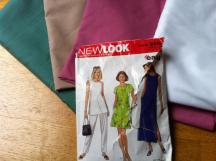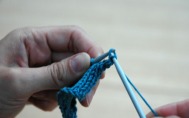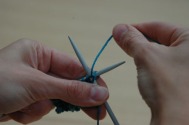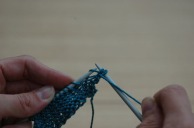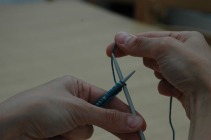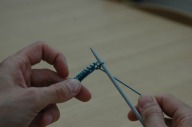After you have completed your phone cover, you may want to try something more challenging and practice the other stitch you have learnt – the purl stitch.
You will also learn that alternating between knit and purl stitch creates new textures in your knitting.
The changes in width and different textures in this knitted cowl make it look more complicated than it is. Most people learn to knit by making a scarf – this is basically a short scarf with the ends attached together. There are no increases or decreases and the pattern uses only the basic ‘knit’ and ‘purl’ stitches. It shows that adding buttons to an item (they are purely ornamental) can really make a difference!
I used 4.5mm needles and double knit acrylic yarn.
Cast on 38 stitches.
Knit stitch for 20 rows. This is called garter stitch – a wavy texture stitch on the front and back.
Knit stitch for one row, purl stitch for next row.
Repeat these two rows twice more.
You now have 6 rows of stocking stitch. The smooth arrow side is the front (right side) of the stitch. The wrong side (back) of the knitting has a wavy texture.
You then move onto the main area knitted in rib stitch.
- Purl 2 stitches (move yarn to back of item) then knit 2 stitches and move the yarn to the front again. Repeat these 4 stitches for the rest of the row (8 times) ending with 2 purl stitches.
- Knit 2 stitches (move yarn to front of item) then purl 2 stitches and move the yarn to the back again. Repeat these 4 stitches for the rest of the row (8 times) ending with 2 knit stitches.
Repeat the 2 rows above until you have 142 rows of rib stitch.
Knit stitch for one row, purl stitch for next row.
Repeat these two rows twice more (6 rows of stocking stitch)
Bind/cast off all 38 stitches.
Loop the length of knitting and sew the last stocking stitch area (where you cast off) behind (on the back of) the first set of stocking stitches. This makes the cowl shape.
You will have realised that the different combination of knit and purl stitches make all the other stitches! You will also see that the rib stitch area of knitting isn’t as wide as the garter stitch area so you have a change in shape without increasing the amount of stitches used. This creates the flared area.

Sew the button detail onto the front of the 'flared' area (see image above), going through the rib knitting behind too
N.B. I already had two buttons – if you are going to buy some especially it might look better with three (an extra in the centre).
If you want fingerless gloves to match take a look here 🙂

